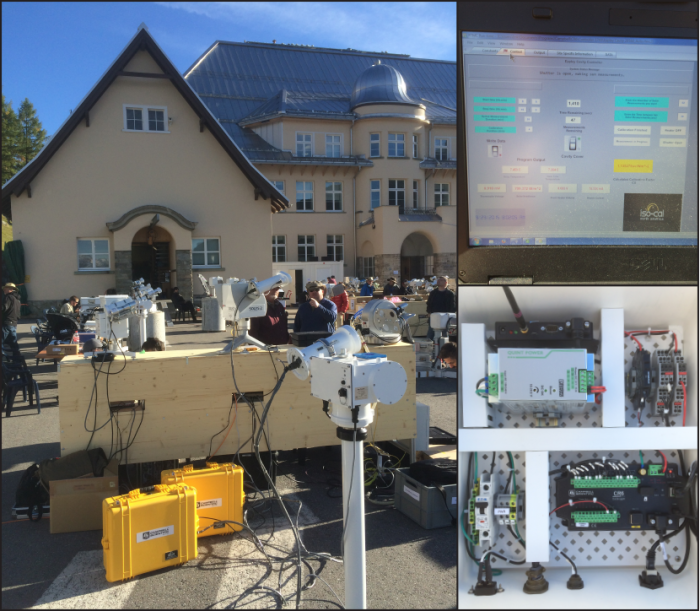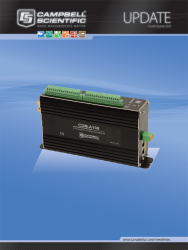
Left: Erik Naranen (ISO-CAL North America) and Duncan Maciver (Atlas Weathering Services Group) look on as the CR6 Absolute Cavity Controllers (in yellow cases) operate Eppley Model AHF cavity pyrheliometers during the IPC-XII International Pyrheliometer Comparisons at the PMOD World Radiation Center in Davos, Switzerland, September 2015.
Upper right: RTMCPRO provides the CR6 controller user interface for entering instrument-specific constants and measurement sequence information to initiate Cavity Controller operation, view measurement results, and generate a daily report.
Lower right: Inside the yellow cases are a CR6 controller, NL240 Wireless Network Link Interface, and power supply. Backplate design follows standard Campbell Scientific prewire best practices.
Direct normal irradiance (DNI) is the solar radiation arriving at the Earth’s surface directly from the sun on a surface held normal to the rays that come in a straight line from the sun at its current position in the sky. This parameter is of utmost importance to the solar-energy industry. The sun’s output at the top of earth’s atmosphere has been measured by a variety of space-based radiometers over several decades. DNI measured on earth’s surface is smaller than that measured at top of the atmosphere, due to scattering and absorption. The value varies due to varying distance between earth and sun, and due to changes in earth’s atmosphere. This parameter is very difficult to forecast and is one of the most expensive measurements in the field of broadband solar and infrared radiation measurement.
The most accurate measurement is provided by pyrheliometers operating as electrically self-calibrating absolute-cavity radiometers (ACRs). The world’s reference for solar irradiance consists of seven of these cavity radiometers manufactured by different companies around the world and is maintained in Davos Switzerland by the World Radiation Center. Absolute-cavity radiometer model HF, manufactured by the Eppley Laboratory, has been a reference-standard-level device since 1978. The sensor consists of a balanced pair of cavity receivers attached to a wire-wound thermopile. The blackened cavity receivers are also fitted with electric heater windings. These heaters allow for absolute operation using the electrical substitution method relating the radiant power to electrical power in SI units. The typical solar-radiation incident on earth’s surface on a bright clear day is of the order 1,000-1,100 W/m2. This produces a maximum signal of about 1 mV. In order to measure this and meet the specifications of World Radiation Center, we need a resolution of about 100 nV.
Almost everyone with a cavity radiometer uses Agilent Digital multi-meter 34970 A or NI 4065 as a controller and measurement. However, a close look at CR6 specifications reveals that we have slightly better accuracy available, as seen from the following table:
| dc Voltage Range | Agilent 34970 A | NI 4065 | CR6 |
|
100 mV range, 24 Hr. 23°C ±1°C |
3.53 µV |
3.03 µV |
2.6 µV, over range 0-40°C |
The accuracy, however, on any of these systems can be improved by removing the offset on measurement channels during the measurement. A resolution of 100 nV or better on the measurement of the thermopile voltage allows an equivalent in radiation of approximately 0.1 Wm-2. In order to be classified as a standard pyrheliometer, we need a sensitivity of ~ 2.0 Wm-2, which would require a voltage measurement resolution better than 2.0 µV. This is easily satisfied by the CR6.
Another feature we need is the capability to excite a voltage of ~ 3 volts for the cavity heater. The CR6 can provide a voltage level of ±2.5 V. However, we can obtain excitation voltages up to 5 volts by using differential excitation, excite +2.5 volts on one channel of the differential pair while simultaneously exciting -2.5 volts on the other. Such excitations can be used only if the circuit is floating and any measurement on the circuit is made differentially. The current requirement is ~ 20 mA, well within the specification of 25 mA on CR6. We also need a control port from the logger to control a shutter on the sensor.
A controller was designed around the CR6 datalogger and a CR6 program was developed in CRBasic to perform the tasks outlined below. An NL240 provides additional communication options and was added at the request of one of the customers.
- Calibration: calibrate the cavity by the method of electrical substitution. This has to be done at the level of solar radiation we desire to measure to avoid any errors due to nonlinearity of the sensor response. First the solar radiation is measured and converted into power by using the sensitivity of the instrument provided by the manufacturer and sensor geometry. We calculate a voltage required to provide this power based on heater resistance. This voltage is excited after closing a shutter on the sensor to cut off solar radiation. Measurement of heater current, heater voltage, and thermopile voltage is made and a new sensitivity factor for the sensor is calculated in proper units.
- Measurement: After finding a calibration factor, make measurements for a predetermined time (typically 30 minutes) and repeat the calibration step.
- Repeat the above steps for the entire day between a start and stop time selected by the user.
- The user inputs are provided from an RTMC screen.
For a more thorough, technical explanation of this process, read the "Development of a New Controller for Absolute Cavity, Cavity Calibration, and Solar Irradiance Measurement" application note.

